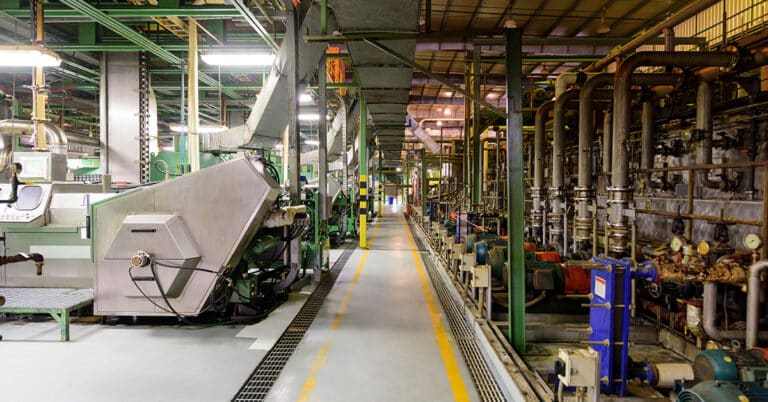Manufacturers don’t have the luxury of believing in “All’s well that ends well.” Even when an order is delivered on time, in full, and without defects, that doesn’t guarantee optimal performance. Hidden inefficiencies and bottlenecks may still exist—quietly eroding profitability. The key to uncovering these issues often lies in closely monitoring machine efficiency.
This is a critical metric for manufacturers, with significant ramifications for production capacity, energy consumption, equipment lifespan and ultimately profitability. Companies that fail to monitor machine efficiency risk wasting valuable resources, even when overall productivity appears to meet expectations. The ends don’t always justify the means, and machine efficiency is a clear indicator of that for those who are willing to see it.
What is machine efficiency?
In short, machine efficiency is the measurement of how effectively a given piece of equipment on the production line performs compared to its potential. It compares how well the machine converts inputs of time, energy and labor into the output of a finished component or product. That performance is contrasted with an expected or theoretical maximum output.
For example, say a specific machine on the production floor has a rated capacity from the manufacturer of 100 units produced per hour. After analysis, however, the manufacturer discovers that said machine actually produces only 75 units per hour. This means the machine is functioning at only 75% efficiency.
Although this may sound similar in concept to the metric of Overall Equipment Effectiveness (OEE), they measure different metrics. Whereas OEE is focused on the quality of the finished product as well as the amount of uptime the equipment delivers, machine efficiency is concerned with productivity above all else. This is why manufacturers would do well to keep a close eye on both metrics as part of their continuous improvement efforts.
The formula for machine efficiency
Calculating machine efficiency is relatively simple, so long as the manufacturer has the baseline for standard output based on machine specs or engineering standards:
Machine Efficiency = (Actual Output ÷ Standard Output) x 100
For example, a machine that is expected to output 100 units an hour outputs 450 units over a five-hour shift. This means it is outputting 50 units less than it is expected to over the same timeframe. According to the formula, this means the equipment is performing at 90% machine efficiency. Of course, this assumes there were no scrapped units, no units requiring rework and no downtime.
Factors that affect machine efficiency
Machine efficiency is not something that increases or decreases in isolation. Rather, there are numerous factors than can influence the performance and output of a piece of equipment, including:
- Operator skill and training: If an operator does not have the proper training to operate the equipment at optimal levels, it’s unlikely the machine’s efficiency will be as high as it should be.
- Preventive maintenance: Being proactive about maintenance rather than waiting until breakdowns occur helps keep equipment in spec for as long as possible, ensuring higher levels of machine efficiency.
- Machine age and condition: Older, worn-out machines are far less likely to deliver the performance needed to keep efficiency high.
- Material quality: When inferior materials lead to defective products, it can have a profound impact on the efficiency of the entire manufacturing process.
- Changeover times and production scheduling: When equipment’s left idle for too long, it can make it more difficult to get back up to speed.
- Environmental factors: Dust, moisture and other environmental contaminants can take their toll on the efficiency of equipment without proper care.
How to improve machine efficiency
Although there are many threats that can impact machine efficiency in a negative way, the good news is that manufacturers have a number of strategies they can use to keep their operations as efficient and productive as possible:
- Implementing predictive and preventive maintenance programs to keep machinery online and at peak performance for as long as possible
- Training operators for consistent performance and making sure they stay current with best practices
- Standardizing workflows and reducing changeover times whenever possible
- Upgrading machinery with automation and condition monitoring sensors
- Utilizing CMMS and IIoT tools to enable continuous efficiency and machine health monitoring data in real-time
- Adopting Lean or Six Sigma methodologies for continuous improvement
Real-world applications and cost savings
Even if equipment is meeting production goals, that doesn’t mean there’s no reason for manufacturers to be concerned about machine efficiency. Even an incremental improvement of 10% can represent thousands in energy and labor costs saved every month. Improving machine efficiency also means manufacturers can continue to get the most out of their equipment without needing to invest in new machines. Taking into consideration the reduced waste, higher sustainability and stronger competitive edge it provides, machine efficiency is an important focal point for manufacturers.
One of the best ways manufacturers can improve their machine efficiency is to work with a qualified maintenance partner who can keep their equipment in good working order for as long as possible. ATS is a leader in industrial maintenance services, offering advanced expertise when it comes to improving machine uptime and availability. To learn more about everything we have to offer, reach out and speak with a member of our team today.






